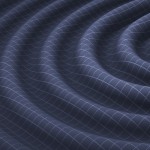Gravitational waves from binaries of black holes and neutron stars
One of the primary data analysis problems we pursue is that of searching for gravitational wave si gnals from binaries of black holes and neutron stars, also termed as compact binary coalescences (CBCs).
gnals from binaries of black holes and neutron stars, also termed as compact binary coalescences (CBCs).
These signals are very weak and fleeting. Finding them requires scanning volumes of very noisy data of a highly complex instrument. Dhurandhar (IUCAA) and his collaborator B. Sathyaprakash (now in Cardiff) from 1991 first proposed how to find them by matching thousands of wave patterns expected from the binaries, as derived from Einstein’s theory, with the data of a LIGO like detector. For further confirmation of the common astrophysical origin of the signals, a multi-detector consistency test is applied. The theoretical foundation for it was laid by Bose and Dhurandhar, along with Archana Pai (now at IISER Thiruvananthapuram). We have worked on the analysis used by LIGO and Virgo for detecting these signals.
A stochastic background of gravitational waves
Members of IUCAA have played a pioneering role in developing data analysis methods for searching such a background, which can be cosmological or astronomical in origin, and using it to characterize its source.
Continuous gravitational waves
Non-axisymmetric spinning neutron stars can emit gravitational waves over long durations. When such a signal is detected it can inform us about how different the emitting star is from a perfect sphere. This information, in turn, can put important constraints on the nuclear equation of state of neutron stars.
SELECTED REFERENCES
Compact binaries
- B. S. Sathyaprakash and S. V. Dhurandhar, “Choice of filters for the detection of gravitational waves from coalescing binaries,” Phys. Rev. D 44, 3819 (1991).
- Sukanta Bose, Sanjeev V. Dhurandhar, Archana Pai, “Detection of gravitational waves from inspiraling compact binaries using a network of interferometric detectors,” Int.J.Mod.Phys. D9, 325-329 (2000).
- Archana Pai, Sanjeev Dhurandhar, Sukanta Bose, “A data-analysis strategy for detecting gravitational-wave signals from inspiraling compact binaries with a network of laser-interferometric detectors,” Phys. Rev. D64:042004 (2001).
- P. Ajith, Sukanta Bose, ” Estimating the parameters of non-spinning binary black holes using ground-based gravitational-wave detectors: Statistical errors,” Phys. Rev. D79:084032 (2009).
- Dipongkar Talukder, Sukanta Bose, Sarah Caudill, Paul T. Baker, “Improved Coincident and Coherent Detection Statistics for Searches for Gravitational Wave Ringdown Signals,” Phys. Rev. D 88, 122002 (2013).
- J. Aasi et al. [LSC, VC, and NINJA-2 Collaborations], “The NINJA-2 project: Detecting and characterizing gravitational waveforms modelled using numerical binary black hole simulations,” Class. Quantum Grav. 31 115004 (2014).
- H.-M. Lee et al. [including K. S. Phukon, V. Pandey, S. Bose], “Gravitational wave astrophysics, data analysis and multi-messenger astronomy,” Invited review, Sci. China Phys. Mech. Astron. 58, 120403 (2015).
A stochastic background of gravitational waves
- Sanjit Mitra, Sanjeev Dhurandhar, Tarun Souradeep, Albert Lazzarini, Vuk Mandic, Sukanta Bose, Stefan Ballmer, “Gravitational wave radiometry: Mapping a stochastic gravitational wave background,” Phys. Rev. D77:042002 (2008).
- Dipongkar Talukder, Sanjit Mitra, Sukanta Bose, ” Multibaseline gravitational wave radiometry,” Phys. Rev. D83:063002 (2011).
- Nairwita Mazumder, Sanjit Mitra, Sanjeev Dhurandhar, ” Astrophysical motivation for directed searches for a stochastic gravitational wave background,” Phys. Rev. D 89, 084076 (2014).
- Anirban Ain, Shilpa Kastha, Sanjit Mitra, “Stochastic Gravitational Wave Background from Exoplanets,” Phys. Rev. D 91, 124023 (2015).
- Anirban Ain, Prathamesh Dalvi, Sanjit Mitra, “Fast Gravitational Wave Radiometry using Data Folding,” Phys. Rev. D 92, 022003 (2015).
Continuous gravitational waves
- Sanjeev Dhurandhar, Badri Krishnan, Himan Mukhopadhyay, John T. Whelan, “The cross-correlation search for periodic gravitational waves,” Phys. Rev. D77:082001 (2008).
